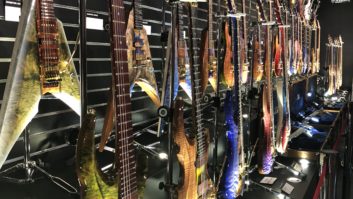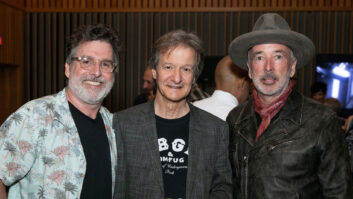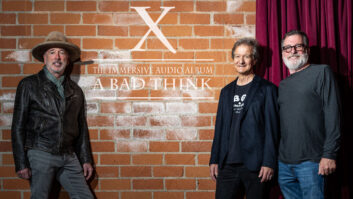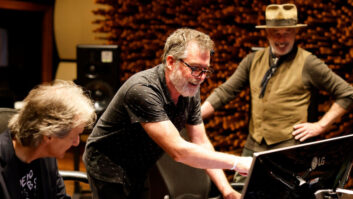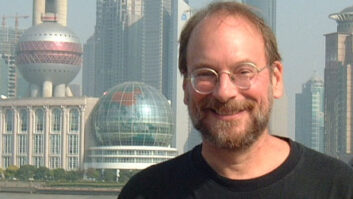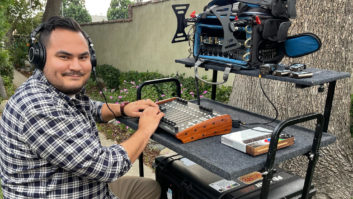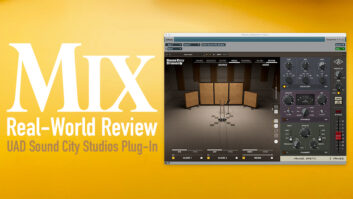NEW YORK, NY—“Would you say there is an energy in the studio when you’re working and recording? How do you recognize when that vibe is going the wrong way?” asked moderator Errol Kolosine during the “Platinum Producers—Bad Vibrations” panel at the recent 139th AES Convention.
Asked to define those vibrations, producer, engineer, musician and studio owner Joel Hamilton replied, “There’s the physicality of the music and then there’s the interaction between everybody making the music. That’s the most easily polluted of the vibrations in the studio.”
For example, “It’s pretty easy to hear the kick drum over somebody bitching on the couch, if you’ve got big enough speakers. It’s really difficult to then come back from that bitching and feel good about that kick drum,” said Hamilton, who is known for his work with artists such as Norah Jones and The Black Keys.
Hank Shocklee, co-founder of Public Enemy and the Bomb Squad production team, noted that where he works has to be conducive and have an atmosphere. “Music is very spiritual, so the first thing I do is reset the calibration of the room. The first thing I do is cleanse the room.” Shocklee uses quartz crystals and selenite wands at his personal studio for that purpose, he said, or will burn incense or oils.
Location is important, but, noted Nick Sansano, an engineer and producer who worked with Public Enemy and Sonic Youth and now teaches at NYU, “It could backfire; you set up expectations that are not attainable. You don’t all of a sudden become a better drummer just because you’re at Muscle Shoals.”
At the AES Convention, this year’s Platinum Producers panel explored detriments to the production process and how panelists work around them. From left: moderator Errol Kolosine, Hank Shocklee, Joel Hamilton and Nick Sansano.




He added, “These grand places with rich history—for me, it usually gets in the way. It’s not my history; it’s somebody else’s story, and I’m there to create a new story with our own original feelings and spirit and vibe.”
Greene Street Recording, where Public Enemy worked, was crusty and dusty, according to Shocklee, and that suited everyone just fine: “You could go in there and be yourself.” He recently visited a modern studio in Manhattan that was “pristine and correct. There were no handprints on anything. I didn’t know whether I should make music or ask for a surgeon.”
Kolosine, a former “label guy” who also teaches at NYU, admitted, “I’ve been the bad vibe in the room.” He asked what advice the panelists had for dealing with business people.
“There really is no reason for any of them to come” to the studio, said Sansano. “It takes a bit of time to acclimate to the listening environment. To be there is of no use creatively; to be there is to impede the process. To make creative commentary is usually incorrect because their perspective is all wrong, and it’s usually detrimental.”
“The thing that is [screwing] the business up now is the lack of connection that the presidents or the A&R people have with the artist,” said Shocklee. Time was, everybody at the label had a vested interest in the music, he said. “They knew all the artists, they knew everything about it.”
Now, he said, “Somebody just fills out the application and they get the job of A&R.” For those people, a new piece of music “comes across like it’s a Pop Tart; there’s no connection. It’s all about numbers and things that don’t have anything to do with music. That’s why the business is in the state that it’s in. Connection has to come back.”
When working with experienced artists, said Sansano, “We put on a show when we know [business people are] coming.” Ironically, as he pointed out, “While they’re there to remind us to be efficient, they’re actually wasting their own money. We play this song, because it’s the closest to being where we want it to be. We play it at this volume. And we’re not going to play anything else. Let’s get them out of this room so we can get on with our work.”
If a label executive does visit the session, said Hamilton, “It feels best to me if it’s pre-or post-session. You know you’re just doing the razzle-dazzle.”
Hamilton also commented that he is sensitive to being pressured to be commercial, but would rather break new ground. “It’s really difficult to be categorized so early in the creative process. I hope you have to make a name for what we’re making, rather than running right up the path everybody has already beaten down.”
Internal conflict amongst the band or between artist and manager can also harsh the mellow vibe in the room, as Sansano explained. “What saps the energy is that you have arguments that are trivial, and you try to bring perspective to them. I’ve had people stand up and leave the studio. That really slows you down,” he laughed.
“You achieve this equilibrium in the room that’s a dynamic between however many people you’re working with, and that gets infected so quickly and easily,” observed Hamilton. “I feel my energy shift depending on who I’m working with. You mold yourself into being the engineer who should be working with that artist. It’s almost method acting; you get inside their brain and then make decisions that are correct for the spirit of their art.”
